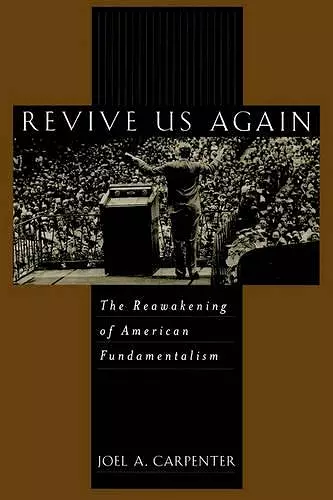Revive Us Again
The Reawakening of American Fundamentalism
Format:Paperback
Publisher:Oxford University Press Inc
Published:29th Jul '99
Currently unavailable, currently targeted to be due back around 25th January 2025, but could change

By the end of the 1920s, fundamentalism in America was intellectually bankrupt and publicly disgraced. Bitterly humiliated by the famous Scopes "monkey trial," this once respected movement retreated from the public forum and seemed doomed to extinction. Yet fundamentalism not only survived, but in the 1940s it reemerged as a thriving and influential public movement. And today it is impossible to read a newspaper or watch cable TV without seeing the presence of fundamentalism in American society. In Revive Us Again, Joel A. Carpenter illuminates this remarkable transformation, exploring the history of American fundamentalism from 1925 to 1950, the years when, to non-fundamentalists, the movement seemed invisible. Skillfully blending painstaking research, telling anecdotes, and astute analysis, Carpenter--a scholar who has spent twenty years studying American evangelicalism--brings this era into focus for the first time. He reveals that, contrary to the popular opinion of the day, fundamentalism was alive and well in America in the late 1920s, and used its isolation over the next two decades to build new strength from within. The book describes how fundamentalists developed a pervasive network of organizations outside of the church setting and quietly strengthened the movement by creating their own schools and organizations, many of which are prominent today, including Fuller Theological Seminary and the publishing and radio enterprises of the Moody Bible Institute. Fundamentalists also used youth movements and missionary work and, perhaps most significantly, exploited the burgeoning mass media industry to spread their message, especially through the powerful new medium of radio. Indeed, starting locally and growing to national broadcasts, evangelical preachers reached millions of listeners over the airwaves, in much the same way evangelists preach through television today. All this activity received no publicity outside of fundamentalist channels until Billy Graham burst on the scene in 1949. Carpenter vividly recounts how the charismatic preacher began packing stadiums with tens of thousands of listeners daily, drawing fundamentalism firmly back into the American consciousness after twenty years of public indifference. Alongside this vibrant history, Carpenter also offers many insights into fundamentalism during this period, and he describes many of the heated internal debates over issues of scholarship, separatism, and the role of women in leadership. Perhaps most important, he shows that the movement has never been stagnant or...
Carpenter's ... narrative is historically weighty but journalistically clear, and vividly recreates the world of the conservatives in the 1930s and 1940s. * Crawford Gribben, Evangelical Times, Oct.2000. *
Carpenters story, like his prose, is vivid and compelling. His presentation of an era of complicated loyalties shows true sympathy for his subjects on both sides of their divisions. His book is to be commended as an outstanding and monumental example of sympathetically evangelical scholarship. * Crawford Gribben, Evangelical Times, Oct.2000. *
"This is crucial book for understanding how fundamentalism built a vital counter-culture during the 1930s and 1940s. Their efforts provided the base for the emergence of the broader evangelicalism of the Billy Graham era and for later fundamentalism. Carpernter is the leading authority on this subject and does a superb job in depicting it."--George Marsden, Francis A. McAnaney Professor of History, University of Notre Dame, and author ofThe Outrageous Idea of Christian Scholarship
"Carpenter's work easily ranks as the premier analysis of American Fundamentalism from the 1920s to the rise of Billy Graham in the 1950s. He weaves theological, cultural, and social strands into a mosaic that is as sweeping in its breadth as it is beautiful in its telling. Sit back and watch a master artist at work."--Grant Wacker, The Divinity School, Duke University
"In this groundbreaking new book, historian Carpenter...argues that fundamentalists did not vanish in the 1930s and `40s--they went underground and built a unique and powerful subculture, with Bible schools, foreign mission societies, seminaries, camp meetings, and mom-and-pop publishing houses.... A valuable contribution to a critical but neglected era in fundamentalist studies."--Kirkus Reviews
"Carpenter's portrait of the lost years of American fundamentalism is compelling religious and cultural history."--Publisher's Weekly
"This is an important book, bristling with insights. ...Carpenter's book is one of the best we have on fundamentalism. He reminds us that, while it is tempting to vilify fundamentalists, they represent a genuine religious tradition whose staying power and influence demand serious attention."--Bruce Hindamarsh, Books & Culture
"Carpenter's book is a carefully researched study of why and how fundamentalist Christians have been able to prove earlier notices of their movement's demise to have been greatly exaggerated."--The Chicago Tribune
"Indispensable....Whether he is sketching some of the dominant figures of the fundamentalist movement, exploring the fruitful tension between the need to be separated from the world and the imperative to evangelize, or recounting the amazing saga of fundamentalism via radio...Carpenter is comprehensive without ever becoming pedantic."--John Wilson, Christianity Today
"A lucid, in-depth account of the creation of an institutional counter-culture for fundamentalism between the 1920s...and the rise of Billy Graham in the 1950s."--David Martin, Times Literary Supplement
"Carpenter has successfully combined institutional, intellectual, and cultural history to write the definitive account of the 'lost years' of American fundamentalism."--Los Angeles Times Book Review
"This is a helpful study of fundamentalism in the 1930s and 40s, which contributes to our understanding of the emergence of contemporary evangelicalism. The tensions withinthis religious outlook are clearly delineated. The book combines attention to specifics with a clear interpretive framework."--Darrell Jodock, Muhlenberg College
ISBN: 9780195129076
Dimensions: 231mm x 155mm x 23mm
Weight: 581g
368 pages